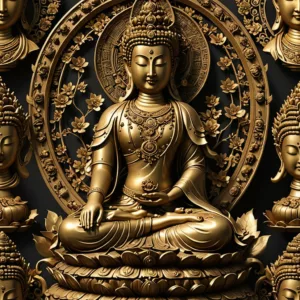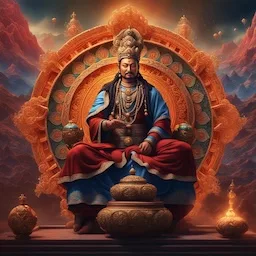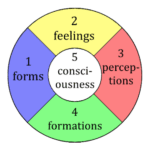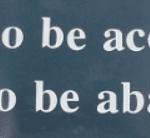The 3 turnings of the Wheel of Dharma represent the overall teaching categories of the Buddha. The first turning is not-self, the lack of inherent existence of the person. The second is the emptiness of all phenomena. The third turning is tathagatagarbha, the buddha nature.

Table of Contents
The First Turning of the Wheel of Dharma
The Budha first turned the Wheel of Dharma at Deer Park in Varanasi. This was soon after his enlightenment. He came upon the three yogis with whom he had practiced previously. They sent him away after he accepted nourishment from a local farm girl as a failed ascetic. Upon his return, they noticed something different and questioned him.
He taught on the lack of true existence of the self and the four noble truths. The thrust of the first turning is not-self. No truly existent, independent, singular self actually exists. The self is a mirage composed of the skandhas, heaps, or aggregates, as they are called. It is somewhat ruled or propelled through samsara by accumulations of karma. The train of karma is known as the nidanas.
Buddha taught that this doctrine can be meditated upon to attain liberation. Consequently, he taught mindfulness as the key component of meditation as part of the first turning.
The study involves learning about the preceding concepts and contemplation of their validity in one’s experience. Do they reflect an accurate map of the self and karma?
Other teachings of the first turning fall into the full Tripitaka, or 3 baskets. This is the codified, officially recognized discourses of the Buddha. The 3 baskets are the abhidarma (mainly the teachings on not-self), the Sutras (many of these belong to the 2nd turning), and the Vinaya – the monastic codes of behavior.
The Second Turning of the Wheel of Dharma
The second turning concerns the teachings on shunyata or emptiness of phenomena. This includes the Noble eight-fold path of the bodhisattva, the 6 paramitas, the 5 paths, the teachings on the bhumis or Bodhisattva grounds, Bodhicitta, the 37 practices of the bodhisattva, and in general any bodhisattva teachings. The key components are prajna (insight into emptiness) leading to wisdom (direct perception of emptiness) and compassion – the desire to liberate beings from the suffering of samsara.
Study, contemplation and practice would include learning the Heart Sutra of the Buddha as the basic teaching. This is also called the Sutra of the Heart of Transcendent Knowledge or the prajnaparamita sutra – perfection of wisdom discourse.
Cittamatra, or mind only, is a key philosophical approach to this turning. Cittamatra posits that all phenomena are mind-only, composed of concepts, rather than substantively existent. Other schools of emptiness arose to correct potential misunderstandings in Cittamatra doctrine – the Madhyamika, especially.
Third Turning of the Wheel of Dharma
Buddha turned the wheel a 3rd time in Vaishali, teaching the dharma of ‘discriminating awareness.’ The third turning overcomes attachment to emptiness, rescuing yogis from the trap of nihilism.

Flow, the profound mental state, also called Peak Performance, can be attained with meditation and can be ‘triggered’ at will, with enough discipline. Guide to Flow Mastery will teach you how.
Tatagatagharba, the Buddha Nature
The last of the 3 turnings, Tatagatagharba, is loosely, though not wholly correlated with Vajrayana, at least in terms of practice. It does fit in the Mahayana view and is generally taught publicly. Tatagatha means ‘the one thus gone,’ and refers to the Buddha having transcended to enlightenment or gone beyond all suffering.
In Vajrayana, Buddha Nature is called Sugatagharba, or gone to bliss. The bliss of enlightenment which cannot be overcome.
The primary discourse is the Uttaratantra Shastra by the future buddha Maitreya. It is not entirely accepted as genuine doctrine of the Buddha. Debate ranges from the Buddha never taught it to – he taught it, but it is not a definitive meaning, rather an encouragement to those who fell into nihilism. Other schools, most notably the Shentong doctrine, claim that the Buddha Nature is the final definitive word of the Buddha.
The Uttaratantra Shastra is composed as both direct explanation and in metaphor for Buddha Nature. It contains 7 Vajra Points
- 3 jewels
- Buddha
- Dharma
- Sangha
- Tatagatagharba (buddha nature)
- Changchub (enlightenment) – meaning purified of obscurations and matured in the enlightened virtues.
- Buddha Qualities
- Buddha Activity
How to meditate like a yogi
and enter profound samadhi
Tatagatagharba abides within emptiness because it is not a fixed, discernable, or tangible, physical substance. It is beyond description. However, it is considered to have an absolute and fundamental reality. It is empty of all relative reality but, as the ultimate, it is not empty of being the ultimate reality – tatagatagharba.
It can be called by many things. It is the unopened Buddha essence, which, if properly developed, nurtured, and watered will reveal itself and mature into full and ultimate Buddhahood. Buddha nature is eternal, indestructible, beyond all harm and help. It is unchanging, neither one nor many, existent nor nonexistent.
It is also called luminosity, the great expanse, and a variety of other names.
The Mahayana approach is to acknowledge the tathagatagarbha, to practice with it, to develop and cultivate it. The Vajrayana approach is to view it as fully developed and matured already, merely hidden behind concepts and thoughts
How would you describe the 3 turnings of the Wheel in Buddhism?
-not-self
-emptiness of phenomena
-Buddha Nature, tatagathagharba
What is the turning of the Wheel in Tibetan Buddhism?
The turning of the wheel in Tibetan Buddhism refers to the 3 times Buddha created a new philosophy of dharma to refine and make more subtle the teachings and the students.
What is the symbolism of the wheel in Buddhism?
The wheel in Buddhism symbolizes Buddha’s refinements of the dharma based on the progress of students in realization and meditative ability.
Conclusion – 3 Turnings of the Wheel
The 3 Turnings of the Wheel are the Buddha’s overall presentation of the view and practice of dharma – the broad scope of the meaning of each section of the teachings.

May all beings be happy
May all beings be peaceful
May all beings be safe
May all beings awaken to the light of their true nature
May all beings be free








